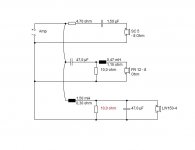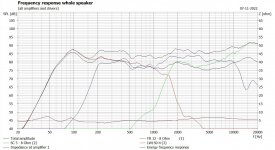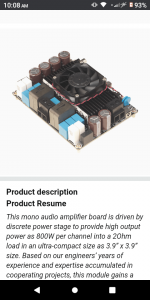I already tried adding a 10 ohm "grounding" resistor in the crossover to solve this, but the distortion above 70% persisted (and it did not sound quite as sweet as without this for some reason).
Attachments
Last edited:
I already tested with a 200W RMS into 6 ohm amp and it worked perfect - but that is not the mission. Unfortunately, I like lithium batteries too, but space really comes at a premium in the flatlands 😟
I also tried this ZK-1002, https://www.amazon.de/Bluetooth-Amplifier-Performance-TPA3116D2-ZK-1002/dp/B087FG37Z7/
but a single channel was not powerfull enough, so I tried (in desperation) bridging the two channels. That worked perfectly for 8 hours untill it burned out 😟
I also tried this ZK-1002, https://www.amazon.de/Bluetooth-Amplifier-Performance-TPA3116D2-ZK-1002/dp/B087FG37Z7/
but a single channel was not powerfull enough, so I tried (in desperation) bridging the two channels. That worked perfectly for 8 hours untill it burned out 😟
Attachments
Last edited:
I'm sorry to say this, but you lack basic understanding of electronics.
The 10 Ohm resistor in your x-over only increases the load for the amp and lowers the bass level.
The amp your "bridged" was allready bridged, you can not bridge a bridged amp. Whatever you did made no sense and so the chip failed. It only played louder in your imagination.
You find all the answers you need in this thread. If you do ignore them, because the fact's don't fit your wishes, it is your game.
Adjust your hearing to the sound pressure your amp can generate or get a 200+X Watt amp.
A last thing to battery powered amps. If you do not include a reasonable voltage safety margain, if fully charged the battery pack will put out more voltage than the amp chip can stand and burn it. Nominal voltage of a battery is not maximum voltage when fully charged. So 3.7V nominal can be 4.4V in reality!
The 10 Ohm resistor in your x-over only increases the load for the amp and lowers the bass level.
The amp your "bridged" was allready bridged, you can not bridge a bridged amp. Whatever you did made no sense and so the chip failed. It only played louder in your imagination.
You find all the answers you need in this thread. If you do ignore them, because the fact's don't fit your wishes, it is your game.
Adjust your hearing to the sound pressure your amp can generate or get a 200+X Watt amp.
A last thing to battery powered amps. If you do not include a reasonable voltage safety margain, if fully charged the battery pack will put out more voltage than the amp chip can stand and burn it. Nominal voltage of a battery is not maximum voltage when fully charged. So 3.7V nominal can be 4.4V in reality!
Thanks. I think 26V is within the allowed range of the amplifier. Does the potentiometer change the input or the gain ?
For the nth time: 26V (or anything around that) will NOT give you the power you need.
On the contrary:
You are trying it in the Audio World and of course it constantly fails, no matter how much you insist.
You already found the answer, now follow it.
On the contrary:
See?I already tested with a 200W RMS into 6 ohm amp and it worked perfect
"Mission Impossible" was a great TV series from 66 to 73 and a barely passable Hollywood movie franchise .... but it was all FANTASY 😉but that is not the mission.
You are trying it in the Audio World and of course it constantly fails, no matter how much you insist.
You already found the answer, now follow it.
Thanks. A compromise maybe ? What if I add 2 lithium cells, that gives me 8 cells appr. 30-36v (with 36v from charger)
What small, mono amplifier board would you then recommend?
What small, mono amplifier board would you then recommend?
Last edited:
A little Math:30V (which is the "stable" voltage under load) means 28V peak (substracting at least 2V from transistor drop, and that, being optimistic) so 19.8V RMS so 65W RMS into 6 ohm.Thanks. A compromise maybe ? What if I add 2 lithium cells, that gives me 8 cells appr. 30-36v (with 36v from charger)
What small, mono amplifier board would you then recommend?
Does 65W sound even remotely comparable to 200W?
Hint 1: you will need way higher voltage than your current power pack can supply.
I mean stable voltage under heavy load.
Most rechargeable batteries, independent of chemistry, rise to higher than nominal voltage when:
a) they are freshly charged.
b) load is minimal or zero (as in 1M meter input impedance)
You can´t base Power calculations on that.
Here in Argentina we have a gross but accurate saying about that: "it will last as long as a fart inside a wicker basket".
Hint 2: you will need at least a stable 51V rail ... under full load that is.
You do the Math as to how many batteries in series you need.
Hint 3: by now it should be clear why you will have to forget any TPA311x based solution, including its somewhat more muscular cousins.
Thanks, but I am not ready to go to +50v and sacrificing the lithium option quite yet. Is TPA3255 any good ?
Example ?A decent discrete class D amp will do well. The inbuilt power inverter will give the voltage needed for >200watts. Really small Taramps will do good from 12v be
Good or not is irrelevant, you do not have an amp problem but a power supply one.Thanks, but I am not ready to go to +50v and sacrificing the lithium option quite yet. Is TPA3255 any good ?
And if so important to you, simply add enough Lithium batteries in series to reach 51V loaded, period.
EDIT: those Taramps are fine, but remember those are CAR amps, designed to be fed from a CAR battery.
EDIT 2:
Closest Taramp, the mono 250W into 4 ohm one, so some 160W into 6, measures:with a small footprint max. 3 x 4 x 1.2"
| Dimensions (WxHxD) | 5.43" x 1.92" x 5.19" (138 x 49 x 132mm) |
|---|
| Maximum consumption in sinusoidal signal | 24 A |
|---|
You seem to have somewhat unrealistic expectations.
Last edited:
Juan,
If you actually have four amplifiers capable of driving down to one ohm or so and have two 24 volt power supplies you can make two bridged amplifiers and then using input transformers you could then place the bridged amplifier pairs in series. That would allow you to exceed 200 watts! Something similar has been done using large power amplifiers to drive an auto race track system.
Of course in this case with limited space and power supply current that technique isn’t really a solution here. In addition probably beyond the current folks skill level.
If you actually have four amplifiers capable of driving down to one ohm or so and have two 24 volt power supplies you can make two bridged amplifiers and then using input transformers you could then place the bridged amplifier pairs in series. That would allow you to exceed 200 watts! Something similar has been done using large power amplifiers to drive an auto race track system.
Of course in this case with limited space and power supply current that technique isn’t really a solution here. In addition probably beyond the current folks skill level.
True. Lots of ampsGood or not is irrelevant, you do not have an amp problem but a power supply one.
And if so important to you, simply add enough Lithium batteries in series to reach 51V loaded, period.
EDIT: those Taramps are fine, but remember those are CAR amps, designed to be fed from a CAR battery.
EDIT 2:
Closest Taramp, the mono 250W into 4 ohm one, so some 160W into 6, measures:
Also:
Dimensions (WxHxD) 5.43" x 1.92" x 5.19" (138 x 49 x 132mm)
Maximum consumption in sinusoidal signal 24 A
You seem to have somewhat unrealistic expectations.
must be fully independent from each other to make a bridge of bridges and account for 48V total ... almost the minimum 51V I am suggesting 😉two 24 volt power supplies
You can´t beat Physics Laws and simple Math, those 49V peak must come from somewhere, either series supplies (actual + 51V) or independent 24.5V peak series signals , fed from separate +37V supplies.
No tongue twisting array can avoid that.
IF the OP has two "36V" batteries as you suggest, and which is not the case, he can either build a complex bridge of bridges, with all the concomitant signal problems (think about the double balanced floating drive signal to begin with, grounding, etc.) or simply wire them in series and feed a normal split supply bridged amplifier, which is at least "doable".
But the solution has been rejected multiple times, the OP is "shopping for opinions" until somebody posts the magical one which meets his desires.
It won´t happen, you can´t avoid Physics Law.
For 200W@6 ohm you need 49V peak into the load, here and anywhere in the Universe.
A bridged amplifier with a 24 volt supply can output a peak to peak voltage of 44 volts or so. Two in series can do 88 or so. Within 2 dB of the goal at 6 ohms, however from the curve shown and Fletcher Munson sensitivities, I would use 4 ohms for the loudness perceived. So probably not noticeable. Lithium cells would more likely produce just a bit more than 25 volts unloaded.
Of course impedance of the load is not a resistor, so voltage and current will not be in phase and power will probably be even lower.
Of course impedance of the load is not a resistor, so voltage and current will not be in phase and power will probably be even lower.
Last edited:
You can research on such boards, (attached image) but I guess you'll need a separate inverter power supply to push voltage to about 60volts.Example ?
But If you're interested in enjoying music and not fixing stuff, I'd recommend you get a car amp that has all these separate systems inside one hood
Edit: Note that many amps that boast of crazy RMS figure from a voltage of 12(-24volts) have an inverter power supply system seated somewhere in between the power source and the amplifier
Attachments
I may not know a giant lot in electronics, but "200" watts from 24v by 6Amps doesn't sit right in one sentence😂. 100watts max on good day, take it or leave itonly have max 24V 6A (not +/-) that can deliver "200w".
A magic trick is to go active. Then 24 volts 6A gives a lot of loudness. But at the expence of complexity and space
- Home
- Amplifiers
- Class D
- What is the most powerful mono class d amplifier board working at 24v (not +/-) ?



